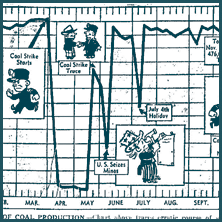 Economic policymakers today have massive amounts of data at their disposal. Their circumstances are drastically different from those faced by their counterparts during the Great Depression. Indeed, armed with little more than stock indices, freight car loadings, and industrial production figures, policymakers struggled to monitor the economy's pulse during the worst economic contraction in modern history.
Economic policymakers today have massive amounts of data at their disposal. Their circumstances are drastically different from those faced by their counterparts during the Great Depression. Indeed, armed with little more than stock indices, freight car loadings, and industrial production figures, policymakers struggled to monitor the economy's pulse during the worst economic contraction in modern history.
The lack of data spawned a push for more and better data collection on the U.S. economy, explains staff writer Lela Somoza in "Part Chart, Part Science: The Evolution of Economic Indicators." As a matter of fact, gross domestic product (GDP), one of the most closely followed indicators, has its roots in the Great Depression. Over time, however, it and other indicators have evolved to keep pace with the changing U.S. economy, which has grown in size and complexity.
Just as indicators have evolved over time to reflect the increasingly complex U.S. economy, their relative importance has waxed and waned also, Somoza notes, pointing to monetary aggregates as a prominent example.
To read more about the evolution of economic indicators since the Great Depression, see the full article in the third-quarter issue of EconSouth. The article also includes a survey of some of the more offbeat indicators economists and others turn to for a more nuanced view of the U.S. economy.


